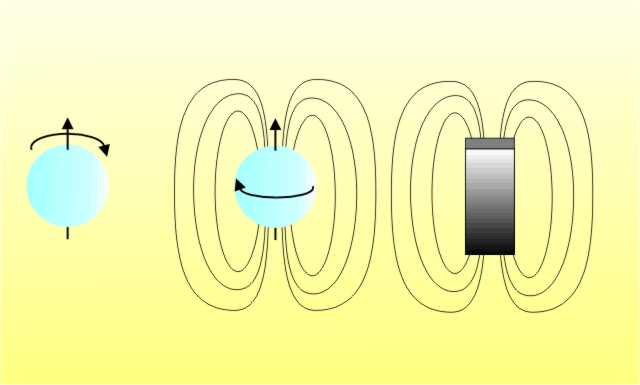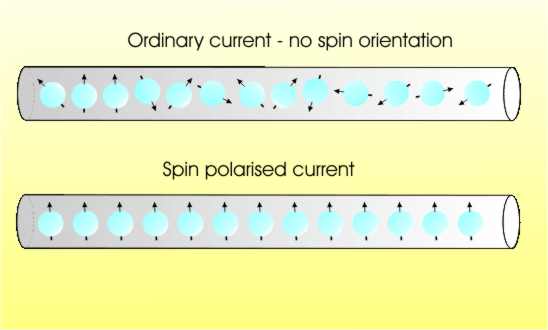| Spintronics |
| Written by Editor | |||||
| Sunday, 30 August 2009 | |||||
Page 1 of 4 Spintronics, an emerging technology based on quantum mechanics, is poised to change everything.
Just like the first electronics revolution, the development of quantum mechanics-based spintronics has the power to effect a major change. The real surprise is that we are already using some of the products of this new way of thinking. This is no long-term dream but quantum computing now. The super sensitive read heads in hard disks and a new type of memory that holds its data without any power are two of the fruits of this new technology but there is much more on the horizon. This is an area of research that is forging ahead and providing new devices much faster than you might expect for something based on quantum mechanics. The electron in a spinElectronics is based on the use of flows of electrons to encode data and to control mechanical devices. All of this technology, computers, radio, TV, GPS, the telephone … is based on one single property of the electron – its charge. An electron is a fundamental particle that is found in every atom. It is tiny, so small that it has no measurable diameter, it’s as close to a point particle as anything we have found. What makes it so important is that it carries an electric charge. The electron carries a unit of negative charge and the whole basic of electronics is making electrons flow in a wire – an electric current. A transistor, for example, uses a small flow of current to control a larger flow and this is called “amplification”. Data in a computer’s memory is generally stored as collections of electrons at specific locations – a lot of electrons represent a 1 and few electrons represent a 0. The electron has properties other than its mass and charge and the one that interests us at the moment is its spin. You can think of this as the electron, imagined as a tiny sphere, spinning about an axis. This is the electron’s spin or angular momentum. There is a consequence of electron spin which is also easy to understand from the diagram below. The electron has a negative charge and so the rotating sphere effectively has small currents of charge circulating around the axis of spin. From classical physics a current flowing in a loop creates a magnetic field and so the electron behaves as a tiny bar magnet with the north and south aligned along the axis of spin.
The conclusion is that, as well as carrying a charge, the electron behaves like a spinning top and a tiny bar magnet. While you are safe in believing these two conclusions you have to keep in mind that we are really dealing with a quantum system and strange things can happen. SpintronicsAt the moment when we make use of an electric current we use a disordered flow in terms of spins. That is, the electrons in a typical microchip have their spins pointing in different directions as they flow. The idea behind spintronics is to make use of spin as well as charge to code information, i.e. electronics using spin. This sounds like science fiction and next to impossible but in fact we have been making use of a particular type of spintronics for centuries! The important point is that a spinning electron acts like a bar magnet. That is, if you put an electron in a magnetic field it will tend to want to align its spin along the field. In the jargon of physics the two states – spin up and spin down - in the field have different energies. It is this simple fact that makes spintronics possible. Spin is all about magnetism and spintronics is really a new way of incorporating magnetic effects into electronics. In a magnetic field an electron’s spin can either be aligned along the field, also called spin up, or against the field, also called spin down. It is these two states that promise to provide a way of storing data.
Magnetism has always been important in science and technology and it is the product of spin. All materials are made up of atoms and an atom can be thought of as a mini solar system with a nucleus of positive-charged particles orbited by negatively-charged electrons. This is a gross simplification and ignores quantum mechanics but it is a reasonable way to begin thinking about the way things work. In the majority of materials the atoms have their electrons arranged in such a way as to produce no net magnetic effect. A few materials, however, do have atoms that are magnetic due to the electron spin. These are called “ferromagnetic” materials and they are used to make magnets. If you have studied even a little physics you will already know that magnetic materials can be magnetised and demagnetised. When the atoms are arranged randomly the material is demagnetised and has no net magnetic field around it. By applying a magnetic field the spins can be made to align in a particular direction. When the external field is removed the spins are still aligned and so the result is a permanent magnet. Ferromagnetic materials were the basis of the first computer memories. Magnetic rings, or cores, were threaded on wires and could be magnetised in one of two possible directions, so storing a 0 or a 1. In this sense spintronics has already played an important part in computing! However, such use of magnetic materials has more or less been completely superseded by integrated circuits. The last bastion of magnetic memory is the hard disk and here we find the first use of what might be called the next generation spintronics. <ASIN:1593271972> <ASIN:0764583689> <ASIN:0071460233> |
|||||
| Last Updated ( Sunday, 30 August 2009 ) |

